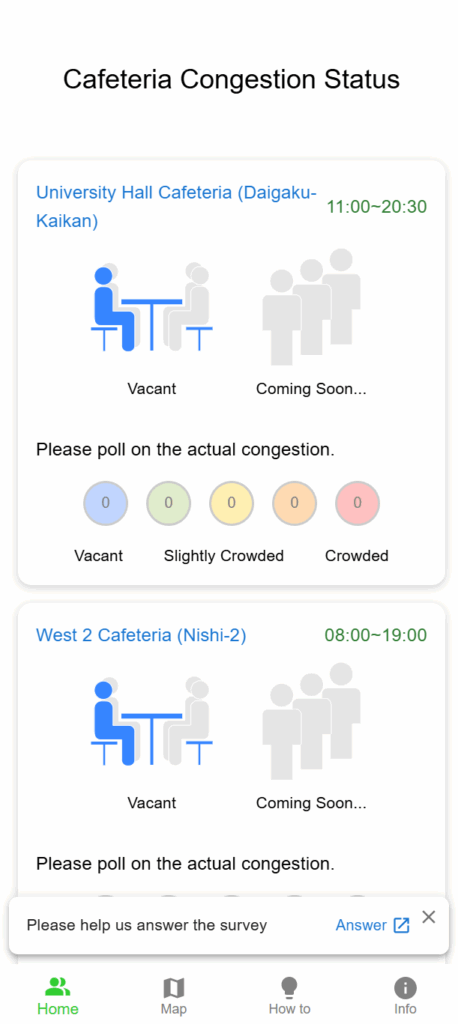A new feature has been launched as a pilot project on Hiroshima University’s official recognition app, the “TGO App,” designed to enhance the comfort of campus life for members of the university community, including students and faculty/staff. This newly introduced feature enables users to visualize cafeteria crowding in real-time.

This service is developed primarily by student fellows from TGIF. It is also part of a broader effort to promote digital transformation (DX) of campus facilities and services, in addition to encouraging problem-solving from students’ ideas. It was designed to address the issue of lunchtime crowding by enabling users to check congestion levels in real time and plan their visits accordingly.
The service was first made available on January 20, 2025 (Mon) for the “University Hall Co-op Cafeteria” via the TGO App. As of April 21 (Mon), it has also been extended to include the “West 2 Co-op Cafeteria.”, with plans to expand to other cafeterias in the future.

The Cafeteria’s Congestion Visualization Service
By accessing the service page within the TGO App, users can easily check the current crowding status of each cafeteria. The degree of congestion is displayed visually using intuitive color codes and icons, categorized into the following three levels:

Note: Crowding status is calculated based on the ratio of the number of entrants to the seating capacity of each cafeteria.
Additionally, users can help verify actual crowding conditions through a rating system (from 1 to 5).
This information enables students, especially those without classes immediately before or after lunch, to avoid peak times or choose less crowded cafeterias. As a result, they can make better use of their limited break time and enjoy their meals without unnecessary stress.
Expected Benefits:
- Crowding Reduction: By encouraging time-based distribution of users, overall congestion in the cafeterias is alleviated.
- Shorter Wait Times: Users can reduce wait times by choosing less crowded cafeterias or time slots.
- Stress Relief: Being able to check congestion levels in advance helps eliminate the stress of searching for a seat.
- Improved Campus Life: A more comfortable dining environment contributes to higher overall satisfaction with student life.
- Operational Efficiency: Usage data can be used to improve future cafeteria management.
How to Use the Service:
Click on the banner for the “TGO App Congestion Visualization Service” on the TGO App homepage to access the feature. It will also be accessible from the “Services” tab in the future.
▶︎ Click here for details about the TGO App
Future Outlook:
Going forward, we aim to enhance the accuracy of this congestion visualization service and explore its potential application to other campus facilities, such as the library. By further promoting digitalization across Hiroshima University, we hope to make campus life even more enriching and comfortable for students. In collaboration with the university co-op, we are also considering adding features such as limited-time menu displays and information on sold-out items.
About the data collection:
These data are measured by collecting the congestion of the cafeteria using two methods: (i) Bluetooth low energy(BLE) signals emitted by devices held by the cafeteria’s users, (ii) the number of people passing through the sensors installed at the entrance and exit of the cafeteria. “BLE signal” is automatically emitted by devices with Bluetooth turned on. This signal contains the MAC address of the device, which is used to identify devices; however, this address is always randomly changed, so it is impossible to identify individuals. Additionally, no signal can be read from devices with Bluetooth turned off. Therefore, by keeping your smartphone’s Bluetooth on, a more accurate estimate of the congestion status can be obtained. We appreciate your cooperation.
Notes: Please note that participation in this experiment is not compulsory for all cafeteria users. You may opt out by turning off the Bluetooth signal on your devices. No equipment capable of identifying individuals will be installed for this experiment, and no personal information will be collected.
How about checking out these posts?
- Check reports from actual users via the “Student Reports” section on the TGO homepage: https://tgo.hiroshima-u.ac.jp/congestion-visualization-service-report/
- Hear from students involved in the development via the “Student Interviews” section on the TGO homepage: https://tgo.hiroshima-u.ac.jp/congestion-visualization-service-interview/

